Justin Fromm, head of insights at Samsung Ads.
For years, advertisers have emphasized managing the linear and streaming TV landscapes, with constant efforts to reach audiences and generate business results. Keeping up with the changing ecosystem is a key challenge as audiences consume more content across several platforms, and cross-platform measurement remains challenging and unreliable.
Marketers have noticed and leaned into the advertising potential presented by streaming and CTV, with growth expected to continue. According to the IAB, total digital video ad expenditure, including CTV, social, and online video, is expected to rise 16% by 2024. CTV, in particular, is anticipated to grow 12% to $22.7 billion by 2024, 32% faster than media overall.
READ MORE: Meta Ad Revenues To Overtake All Linear TV By 2025
While advertisers acknowledge CTV’s capacity to reach their target consumers, modern television viewing is multichannel. Successful TV advertising campaigns necessitate a careful allocation of expenditures across both linear and streaming platforms; the trick is striking the best balance between the two. To achieve this balance, advertisers must have actionable audience information across the whole TV environment.

As viewing behaviors change, linear becomes incremental to CTV.
“The Rule of 40,” which was first published in 2021, proposed shifting 40% of TV budgets to CTV in order to successfully reach audiences based on viewing behavior at the time. Moving forward to 2024, watching habits have evolved much further. According to Samsung’s own statistics, 63% of Smart TV viewers choose streaming entertainment over linear TV. These viewers mostly watch streaming content; many do not watch linear television at all. Furthermore, since that streaming content is no longer primarily ad-free, methods must evolve.
READ MORE: Ad Spending On Linear TV Down 7% In February, According To Guideline
Samsung Ads updated its “Rule of 40” report to assist advertisers in reaching these increasingly streaming-centric users. Samsung advertising used its proprietary automated content recognition (ACR) data, which recognizes all content and advertising that appear on linear TV, to determine the effectiveness of linear ads in reaching streaming-centric users.
Using ad campaigns from several industry verticals, the team created a reach curve that examined the distribution of linear ads to streaming-centric audiences.

Even the most extensive linear ad campaigns reach only 17% of the streaming-centric population. This means that linear ad campaigns will be unable to reach 52% of the total TV universe, prompting advertisers to reconsider their TV advertising strategy. The paradigm has evolved, and linear is now incremental to CTV.
READ MORE: New Warning Signs Emerge Amid Linear TV’s Slow Decline
With the rise of ad-supported streaming, marketers may now target the majority of streamers with their ads, including both streaming-centric viewers and those who use streaming to supplement linear viewing. According to Samsung Ads’ internal data, ad-free viewing has fallen every quarter over the last year, and ad-supported streaming currently accounts for approximately two-thirds of total streaming time.

CTV’s influence goes beyond reach.
To have a significant commercial impact, it’s critical to begin with streaming and CTV, fully exploring its potential as a powerful instrument for delivering results. CTV enables advertisers to go beyond simply increasing reach; it improves how they communicate with their target audiences. Advertisers can use dynamic, interactive ad formats to encourage quick audience engagement and action from the largest screen in the home. CTV enables new optimization, measurement, and attribution opportunities, ensuring that advertising are viewed and successful.
While the “Rule of 40” has served as a useful guidepost for advertising, it can no longer be considered a mere guideline. It is time to reconsider long-held beliefs that linear TV budgets should take precedence in allocation. For the modern multichannel viewing experience, TV advertisers are making CTV the core of their strategy for efficient and effective reach, while also combining linear TV to reach the incremental viewers that remain.
Radiant TV, offering to elevate your entertainment game! Movies, TV series, exclusive interviews, music, and more—download now on various devices, including iPhones, Androids, smart TVs, Apple TV, Fire Stick, and more.


